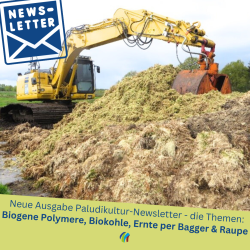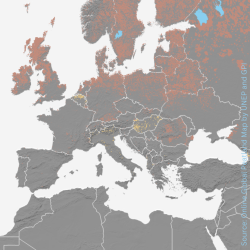News
2024
Yeah! German Environmental Award for GMC manager
by Dorothee Scheuch (comments: 0)
Congratulations
29/08/2024 Congratulations! Dr Franziska Tanneberger has been awarded the German Environmental Award of the German Federal Environmental Foundation (DBU) 2024, recognising the co-director of the Greifswald Mire Centre (GMC) as one of the world's most influential researchers on peatlands and their role in climate and biodiversity. She is regarded as a driving force in the revitalisation of peatlands and as a bridge builder between science, politics and agriculture. She shares the award with engineer Thomas Speidel from Nürtingen near Stuttgart.
This is the third time in a short period that one of the most highly endowed environmental awards in Europe has gone to a representative of peatland research in Greifswald. In 2021, "Moorpapst" Prof Hans Joosten was one of the two winners of the annual award, which is endowed with a total of 500,000 euros. In 2015, Prof. Michael Succow was honoured with the award as an exceptional personality in nature conservation. On 27th October, Federal President Frank-Walter Steinmeier will present this year's German Environmental Award in Mainz.
"As an excellent and globally recognised peatland researcher, Franziska Tanneberger and her team have worked tirelessly to place the importance of peatland protection and rewetting for a future worth living in political decision-making processes both nationally and internationally," explains DBU Secretary General Alexander Bonde. A landscape ecologist by training, she completed her doctorate on the sedge warbler and wrote her habilitation treatise on "Biodiversity and ecosystem services of near-natural and rewetted fens in Central and Eastern Europe - between wilderness and paludiculture". Today she teaches and researches at the University of Greifswald. Since 2015, Dr Franziska Tanneberger has headed the Greifswald Mire Centre together with Dr Greta Gaudig. It is a cooperation between the University, the Michael Succow Foundation and Duene e.V.. Franziska Tanneberger is a member of the German Federal Government's Council for Sustainable Development (RNE).
Biogenic polymers, biochar, peat moss harvesting
by Dorothee Scheuch (comments: 0)
New paludiculture newsletter

25/07/2024 Biogenic polymers and biochar - both can be related to paludiculture and are the subject of the latest issue of our newsletter. A look at the final report from MOORuse reveals that natural fibres from paludiculture are suitable as biogenic polymers in terms of sustainability, for example for injection moulding or 3D printing. In England, researchers are investigating whether biochar on paludiculture areas increases their carbon storage. We present the interactive online version of the Global Peatland Map and a legal report on rewetting in Germany and its obstacles. And of particular interest to land users: information on current funding for machinery and equipment for paludiculture!
We hope you enjoy reading the newsletter and would be pleased to receive feedback on it by e-mail to communication@greifswaldmoor.de.
Invitation: Conclusion "TyphaSubstrat"
by Dorothee Scheuch (comments: 0)
50% less peat is possible

22/07/2024 The aim of the three-year TyphaSubstrat project - harvesting and utilising cattail as an alternative substrate material for press pot soil in vegetable growing - was to develop a peat-reduced press pot soil with up to 50% less peat. At the final event on 5 September in Darmstadt, the project participants will present their results. These show: 50% peat reduction in pressed potting soil is possible! Presentations and dialogue in the morning at the Forschungsring e.V. in Darmstadt will be complemented by a tour of the practical tests in a vegetable nursery and a young plant farm near Mannheim. Detailed information on registration and the programme can be found here.
TyphaSubstrat focuses on cattail in a mixture with other peat substitute components such as sphagnum, green waste compost and wood for press pots, on which lettuce and vegetables are grown commercially. In addition, special technology for harvesting cattail was further developed in the project, and cattail raw material was analysed with regard to substrate properties, including pesticides and herbicides. By reducing the use of peat and utilising paludiculture biomass, TyphaSubstrat makes a dual contribution to the transformation towards climate-neutral use of wet peatlands (paludiculture) and demonstrates possibilities for sustainable substrate production. The proven suitability of cattail biomass as an alternative substrate offers the industry a new renewable raw material that can be produced regionally. A step towards a long-term secure and climate-friendly raw material supply and a contribution to peatland protection. TyphaSubstrat is funded by the German Federal Ministry of Food and Agriculture via the Agency for Renewable Resources (Fachagentur für nachwachsende Rohstoffe e.V.).
Global Peatland Map 2.0!
by Dorothee Scheuch (comments: 0)
Now online

18/07/2024 The GMC's Global Peatland Map is now available online and interactive! It comprises eleven pages and covers a wide range of topics, such as the extent of peatlands per country, greenhouse gas emissions, biodiversity hotspots, peatlands in protected areas and sources of fire. A series of story maps “Peatlands in the Continents” will complement the Global Peatland Map 2.0. for a detailed look at regions offering key facts on peatland distribution, degradation and options for action. Visually intuitive, easy to navigate and beautifully designed, a first story map on Asian Peatlands can already be tried out.
The web version of the Global Peatland Map is based on data from the Global Peatlands Assessment from 2022, which summarized the best available scientific data to provide an overview of the state of peatlands worldwide. As a partner in the Global Peatlands Initiative, the GMC's map specialists created the online version in close cooperation with the World Environment Situation Room of the United Nations Environment Programme (UNEP).
Climate, water, biodiversity in peatlands and floodplains
by Dorothee Scheuch (comments: 0)
Statement of the Leopoldina

27/06/2024 Climate, water, biodiversity - how this is connected in peatlands and floodplains, what condition it is in and how it can be improved - is now summarized in Climate - Water Balance - Biodiversity: For an integrative use of moors and floodplains, the statement published today by the German National Academy of Sciences Leopoldina. "Nowhere in Central Europe is biodiversity as high as in these wetlands," says Leopoldina member Prof. Dr. Klement Tockner, Director General of the Senckenberg Gesellschaft für Naturforschung. Near-natural peatlands and floodplains are also essential for preventing flood disasters and reducing CO2 emissions. The statement with supplementary digital dossier emphasizes the need to rewet peatlands and restore floodplains. Both are already enshrined as climate and biodiversity goals, for the EU for example in the Nature Restoration Law recently adopted by the EU Environment Council and worldwide in the UN Convention on Biological Diversity. The latter provides for the protection and restoration of at least 30% of the world's land, freshwater and marine areas by 2030. The statement now presents options for action to achieve national and international commitments in climate, water and biodiversity protection and still be able to use these areas economically. This includes protecting intact peatlands, switching to paludiculture, rewarding ecosystem services and including the measures in CO2 emissions trading. Twelve scientists from the fields of ecology, biology, hydrology, sociology, agricultural engineering, environmental economics and law were involved - including Dr. Franziska Tanneberger and Prof. Jürgen Kreyling, two scientists from the Greifswald Mire Centre.











